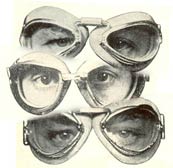FOREST MYRTEN "IRON HAT" JOHNSTON
 |
Forest Myrten “Iron Hat” Johnston was
born January 12, 1904. The “Iron Hat” moniker
came from the derby he wore while flying. He was billed
as the “king of stunt flyers” and his preferred
airplane was the Aeronca C-2. Image, below, is of an
advertisement for his stunting show (note the two different
spellings of his name).
His airshow work included the standard loops and rolls with
his C-2, as well as take-offs and landings on a special platform
rigged on top of a speeding automobile. He also picked
up a handkerchief from the ground with a hook attached to
his left wingtip.
Pilot Johnston landed solo at Tucson June 25, 1930 flying
Aeronca C-2 NC568V. Having left Cincinnati, OH, he was westbound
from El Paso, TX to Oakland, CA. The C-2 is a small
single-place airplane, sometimes referred to as a “vest
pocket edition” of an airplane because of its size,
or the "flying bathtub" because of its guppy-like
fuselage shape. It couldn't have been a comfortable cross-country
machine. Yet, when he landed at Tucson, Johnston was
on a month-long tour with NC568V that began on June 19th
and ended July 19th.
"Iron Hat" Advertisement
 |
From his NASM dossier (reference in left sidebar) we know
exactly what his itinerary was (table below) that brought
him to Tucson with his Aeronca. His flight covered
2,022 miles in 62 hours and 12 minutes. This averages
to about 32 miles per hour across the ground. Like
I said, it couldn’t have been a comfortable cross-country
machine.
It’s interesting to note a few things about his itinerary
that are mentioned in his NASM dossier. The
following anecdotes were captured during an interview with
Johnston December 29, 1977, as recorded in his record. He
gives us a good appreciation of what it was like to fly a
small airplane cross-country in the early 1930s.
Flying across Texas he was advised to follow highways in
case of emergencies. The “flats” mentioned
at Pecos were actually flat tires. He landed in an
open space near town that he said, “…might be
called an airport, but was a very small area scraped out
of the bush. [It was] rough and full of small thorn/burr
type objects [goat heads?] that gave me two flats which were
repaired and the take-off made from the road with success.”
Johnston's Itinerary with NC568V
 |
He said of his visit to El Paso, TX, “[I] only recall
being given two horned frogs or toads as mascots that stayed
with me until El Centro, California when they jumped ship
somehow. Also the hangar doors were opened for me to
fly thru the hangar, and a take-off from inside the hangar. Don’t
recall either event.” Try that today and see
what happens!
He endured a forced landing thus, “Somewhere over
either N.M. or Arizona put-puting [sic] along the highway
at low altitude to avoid headwinds the C-2 quit cold. Landed
straight ahead on the concrete or hard surface and pulled
the airplane tail first off the highway just in time to let
a car pass that had just made the blind corner ahead. The
driver returned and together we looked the AERONCA over. Nothing
was found wrong with the engine. After letting the
engine cool it ran perfectly. The driver of the car
returned and blocked the curve and the take-off went perfectly
normal. The engine never acted up again, and it was
never known what caused it to quit.”
He further says about his “Bunker T.O.” at Benson,
AZ, “In the barren country, flights were made from
highway gas station to station. Log shows Benson, Arizona. The
take-off into the wind was short with obstructions. The
run was made downhill [on a golf course] then pull up over
a bunker which deflected the wind upward thus clearing the
high hazards.”
F.M. Johnston's Pilot Certificate
 |
Now we find him in Tucson on June 25th after a 50 minute
flight from Benson, AZ. Notice his mention of the “big
login register”. If you click on THE REGISTER
above, right, you’ll see a picture of the original
Register that Johnston signed. It is, indeed, big. Of
all the pilot and passenger biographies on this website,
Johnston’s is the only one where our Register is specifically
mentioned in any of the documents I have researched.
Although not apparent from his entry in the Register, according
to the table above, Johnston remained in Tucson overnight,
departing on the 26th. After he left Tucson he had
another incident as he reached California. “Before
reaching Imperial, California at dusk the C-2 gas tank started
oilcanning due possibly to vibration. Wet feet since
the tank was above the feet and the drip into the shoes. Tank
removed and repaired and the flight continued to Oakland,
California’s muni airport.”
Image, below, is of a C-2 Aeronca from the Juptner reference
in the left sidebar, volume 4, page 167. This is NC561V,
sister ship similar to the one Johnston flew to Tucson. All
Aeroncas were manufactured by the Aeronautical Corporation
of America located at Lunken Airport in Cincinnati, OH. All
were powered by a 2-cylinder, 26HP engine. Cruising
speed is listed as 65MPH; maximum speed 80MPH. Interestingly,
the fuel capacity of 8 gallons would take the airplane 240
miles. Do the math. That’s 30 miles per
gallon: better than most automobiles then or now! And
the single pilot could carry 50 pounds of baggage.
Aeronca C-2
 |
“Iron Hat” Johnston flew farther West on March
10, 1994 from Oakland, CA.
---o0o---
Dossier 2.1.105
UPLOADED: 06/05/07 REVISED:
|






